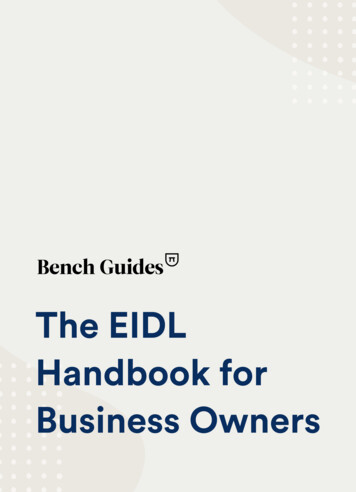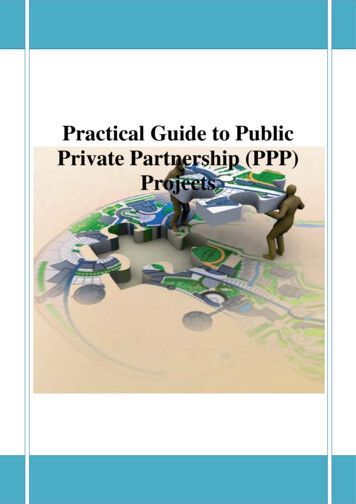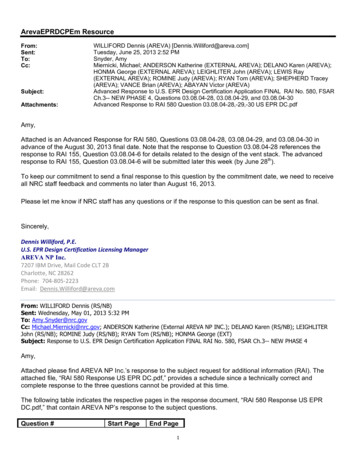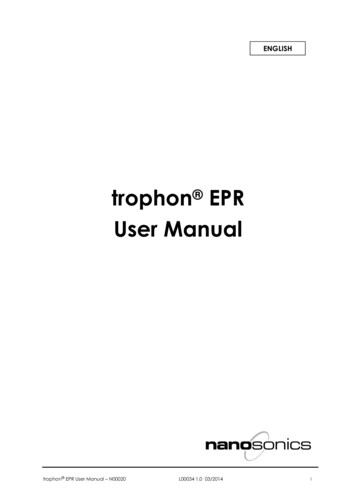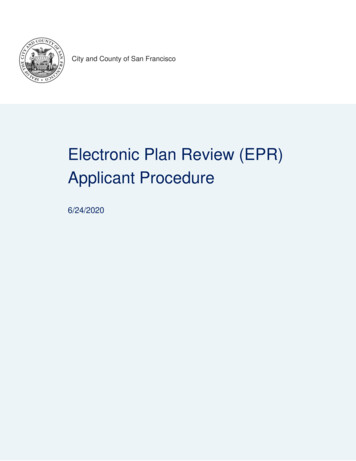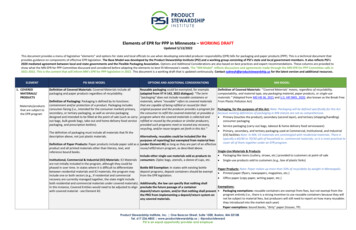
Transcription
Elements of EPR for PPP in Minnesota – WORKING DRAFTUpdated 5/13/2022This document provides a menu of legislative "elements" and options for state and local officials to use when developing extended producer responsibility (EPR) bills for packaging and paper products (PPP). This is a technical document thatprovides guidance on components of effective EPR legislation. The Base Model was developed by the Product Stewardship Institute (PSI) and a working group consisting of PSI’s state and local government members. It also reflects PSI’s2020 mediated agreement between local and state governments and the Flexible Packaging Association. Options and Additional Considerations are also based on best practices and expert recommendations. These columns are provided toshow what the MN EPR for PPP Committee discussed and considered before adapting the elements to best fit Minnesota’s needs. The “MN Model” reflects discussions and agreements made through the MN EPR for PPP Committee calls in2021-2022. This is the content that will inform MN’s EPR for PPP legislation in 2023. This document is a working draft that is updated continuously. Contact sydneyh@productstewardship.us for the latest version and additional resources.ELEMENT1. COVEREDMATERIALS/PRODUCTSMaterials/productsthat are subject tothe EPR programPSI BASE MODELOPTIONS AND ADDITIONAL CONSIDERATIONSDefinition of Covered Materials: Covered Materials include allpackaging and paper products regardless of recyclability.Reusable packaging could be exempted, for example(adapted from VT H 142, 2022 dialogue): “The term“packaging” does not include reusable containers orDefinition of Packaging: Packaging is defined by its functions:materials, where “reusable” refers to covered materialscontainment and/or protection of a product. Packaging includesthat are capable of being refilled or reused for theirconsumer-facing (i.e., intended for the consumer market) primary, original purpose and the producer provides a program forsecondary, or tertiary packaging, as well as service packagingthe consumer to refill the covered material; or provides adesigned and intended to be filled at the point of sale (such as carry- program where the covered materials is collected andout bags, bulk goods bags, take-out and home delivery food service refilled or reused by the produce or similar producers,packaging, and prescription bottles).provided such programs meet or exceed any recovery,recycling, and/or reuse targets set forth in this Act.“The definition of packaging must include all materials that fit thedescription above, not just plastic materials.Alternatively, reusables could be included (for thepurposes of reporting) but exempted from material feesDefinition of Paper Products: Paper products include paper sold as a (under Element #6) as long as they are part of an effectiveproduct and all printed materials other than literary, text, andreuse/refill/return program, as described above.reference bound books.Include other single-use materials sold as products toInstitutional, Commercial & Industrial (ICI) Materials: ICI Materials consumers: Ziploc bags, utensils, a sleeve of cups, etc.are not initially included in the program, although they could bephased in over time. In states where it is difficult to differentiateBottle Bill Exemption: In states with existing bottlebetween residential materials and ICI materials, the program maydeposit programs, deposit containers should be exemptinclude one or both sectors (e.g., if residential and commercialfrom the EPR legislation.recovery are currently managed together, the state might includeboth residential and commercial materials under covered materials). Additionally, the law can specify that nothing shallIn this instance, Covered Entities would need to be adjusted to align preclude the future passage of a containerwith covered material - see Element #2.deposit/return system, and/or that nothing shall preventthe PRO from implementing a deposit/return system onany covered materials.MN MODELDefinition of Covered Materials: “‘Covered Materials’ means, regardless of recyclability,compostability, and material type, any packaging material, paper products, or single-usematerials.” (Adapted from MD HB 36, 2021 and U.S. HR 5845, 2020, also known as the Break FreeFrom Plastic Pollution Act)Packaging, for the purposes of this Act: Note: Packaging will be defined specifically for this Actbecause existing definitions of packaging in MN statute are not as comprehensive. Primary (touches the product), secondary (second layer), and tertiary (shipping/handling)consumer packaging Service packaging (carry-out bags, takeout & home delivery food serviceware) Primary, secondary, and tertiary packaging used at Commercial, Institutional, and Industrial(CII) facilities Note: In MN, CII materials are commingled with residential materials. There istypically a 60/40 to 70/30 split of household vs. commercial materials, so it is most practical tocover all of them together under an EPR program.Single-Use Materials & Products Packaging-like items (cutlery, straws, etc.) provided to customers at point-of-sale Single-use products sold to customers (e.g., box of plastic forks)Paper Products: Note: Paper makes up more than 50% of recyclables by weight in Minneapolis. Printed paper (flyers, newspapers, magazines, etc.) Office paper (copy paper, writing paper, etc.)Exemptions: Packaging exemptions: reusable containers are exempt from fees, but not exempt from theprogram entirely (i.e., there is a strong incentive to use reusable containers because they willnot be subject to material fees, but producers will still need to report on how many reusablesthey introduced into the market each year)Paper exemptions: bound books, “dirty” paper (tissues, TP)Product Stewardship Institute, Inc. One Beacon Street, Suite 1500, Boston, MA 02108Tel. 617.236.4855 www.productstewardship.us @productstewardPSI is an equal opportunity provider and employer
2. COVERED ENTITIESStakeholders thatmay use the EPRprogram.The following are considered covered entities:Single & Multi-Family Residences: Both single-family and multifamily residences are included in the program. The goal is toharmonize service levels statewide to the extent feasible and toimprove upon the system such that residents do not lose services.Depots/Drop-offs/Transfer Stations: Producers shall use existinginfrastructure to the extent it is technologically feasible andeconomically practical, including existing depots, drop-off sites andtransfer stations.In states with no existing bottle deposit law: Stringentrecovery, reuse and/or recycling targets may be placed onbeverage containers, either in statute, rules, or in thestewardship plan. If these targets are not met in a giventimeframe, the law could require a deposit/return systemto be implemented – also see Element #9.Some legislation covers only entities currently served by The program will include recycling collection from:or eligible to be served by municipalities (either directly Single & Multi-Family Residencesor through a contract between the muni and a private Depots/drop-offs/transfer stationsentity). Public places (parks, trailheads, downtowns, municipal offices ) Commercial, Institutional, and Industrial (CII) facilitiesAlternatively, covered entities may also have theirrecycling costs covered if they are served directly byprivate service providers (e.g., subscription communities, Recycling collection must be covered by the PRO (either directly or indirectly – see element #7 forICI facilities).details) wherever state or local law requires recycling. Note: In MN there are state requirementson which industries must have recycling – all multi-units, many counties/cities have stricterrequirementsPublic Places: Through the statute or regulatory process, the stateshould require that the stewardship plan include expansion of theexisting (baseline) recycling program to include public places wherethey are not already covered within a set timeline. Under municipalreimbursement, collection in public places should be a reimbursableexpense.Institutional, Commercial & Industrial (ICI) Facilities: If the existinglocal government recycling service combines residential service withservice to ICI sectors, and the EPR program includes more thanresidential PPP in covered materials (see #1), the level of service inthe recycling program should account for these sectors (e.g., ifcommercial materials are covered, commercial entities would becovered by the program).3. COLLECTION &Maintaining & Expanding Current (“Baseline”) System: The existingCONVENIENCErecycling system needs to be stabilized and improved (includingexpanded) to capture more covered materials. The EPR for PPPThe minimum level of recycling program should, at a minimum, continue (via statute) thecollectionsame level of service as the existing recycling program (e.g., state,convenience that amunicipality/waste district, private subscription, or other existingstewardship planservice) – this is the “baseline” program. The stewardship plan shallmust provide tobe required (via statute) to outline how the recycling program willCovered Entitiesalso build on and expand beyond baseline recycling services. TheAdvisory Council can recommend future program expansions andimprovements (see Element #4).Subscription Communities: In communities with privatesubscription services, the PRO must ensure that residents areprovided free recycling collection. All covered entities (e.g.,Product Stewardship Institute, Inc.Elements of EPR for PPP Legislation WORKING DRAFTThe program will also cover processing of covered materials at: MRFs Creating a uniform list of recyclable materials: TheAgency/PRO/Advisory Committee could be charged withdeveloping a statewide list of “recyclable” materials thatare suitable for collection within the program. Forexample: “The Agency shall regularly publish a list ofreadily recyclable materials, developed throughcoordination with the producer responsibility organizationand material recovery facilities or other entities managingcovered materials. The Agency shall provide for atransitional period between the time that a type ofcovered material is determined to be readily recyclable orto not be readily recyclable and the time that suchdeterminations will be effective for the purposes ofdetermining producer payments and collectorreimbursements The Agency may amend the list ofCertain composting facilities: Certain facilities accepting certified compostable coveredmaterials may be covered under the program, depending upon the results of the NeedsAssessment and subsequent plans for targeted investments in the approved stewardship plan.Maintaining & Expanding Current (“Baseline”) System: Existing recycling services shall continuethroughout the state – especially curbside recycling services, wherever they are currently offered.(In other words, there can be no decrease in recycling convenience after the law takes effect.)The PRO/s must work with existing infrastructure (from collection through processing) throughoutthe state to ensure there are no stranded assets.Subscription Communities: The PRO/s shall directly provide for recycling collection wheremunicipalities do not – see Element 7 for details.Convenience Standards: All “covered entities” (see Element 2) must have access to convenientrecycling collection services, either through a municipality or tribe, or through the PRO/s.Recycling collection must be as convenient as the collection of trash in each jurisdiction.Page 2 of 18
residents, businesses) use the system for free – they do not payservice fees or incur costs for the collection of their recyclables. Toaddress concerns of a monopoly if PRO takes over collection insubscription communities: the bill should specify that the PRO shalluse existing infrastructure and services to the maximum extentfeasible. For example, from NY: “[the stewardship plan shalldescribe] how the producers, or the producer responsibilityorganization, will work with existing waste haulers,material recovery facilities, recyclers, and municipalities tooperate or expand current collection programs to addressmaterial collection methods.” Another example from VT – allows any hauler to “opt-in”to the system: PRO must provide payment at thedetermined “reasonable rate” to any vendor who wants it.readily recyclable materials as needed.” (MA H878, 2021- “A producer or producer responsibility organization shall provide for widespread, convenient, and2022)equitable access to collection opportunities for the covered materials and products identified underthe producer or producer responsibility organization's plan at no additional cost to all coveredAlso see OR SB 582 (2021) SEC. 22: Uniform statewideentities. Such opportunities shall be provided to all residents of [the state] in a manner that is ascollection list and producer-collected materials.convenient as the collection of municipal solid waste.” (Adapted from NY S-1185C, 2021).Other options for convenience standards: Producersmust provide at least one drop-off location within eachtown/jurisdiction (if “as convenient as trash disposal” isnot appropriate). Curbside collection could be required injurisdictions with a large enough population (orpopulation density) – numeric threshold to bedetermined as appropriate for a given state.Defining “recyclable” materials: The Agency (MPCA) shall publish a statewide list of “recyclable”covered materials that are suitable for collection within the program, with input from the PRO/s,the Advisory Council, and other key Minnesota stakeholders (e.g., REC, RAM, MNCC). The list shallincorporate existing data and recommendations available in the state. The PRO/s mustcommunicate the list to all participating producers and any entity receiving reimbursement forrecycling services, as well as to the general public (see Element 10 for details). All coveredmaterials on the statewide list must be collected for recycling in all jurisdictions across the state.Stipulations around Alternative Collection Programs(adapted; full text in ME LD1541, 2021): “In determiningConvenience Standards:whether to approve a proposed alternative collectionProducers must provide convenient, free, and on-going consumerprogram, the Agency shall consider:access to collection facilities and/or collection services that are as(1) Whether the program will provide year-round,convenient as trash disposal.convenient, free, statewide collection opportunities(2) To what extent the program intends to manageWhere curbside pickup is not available, producers are required tomaterials through reuse, recycling or incineration.provide convenient, equitable access to permanent collection(3) Whether the education and outreach strategiesfacilities that are within a reasonable drive time to 95 percent of thecan be expected to significantly increase consumerpopulation.awareness of the program throughout the State;(4) How the program intends to measure the amountIf there are existing state or local laws that set standards for serviceof each material type collected, reused, recycled,(e.g., curbside pick-up, plastic bag drop-off, etc.), producers mustincinerated or otherwise managed under themeet or exceed those standards (also see preemption & relatedprogram;laws, #16).(5) To what extent approval of the program maydisproportionately impact any community in theAlternative Collection Programs: If the state oversight authorityState.”agrees that a material (such as plastic bags) is not suitable for themost convenient means of collection available, another means ofOption to limit approval of waste combustion/resourcecollection can be used.recovery/waste to energy (WTE): The Agency may notapprove a program that proposes management byincineration unless that material is not readily recyclableor compostable and the program proposes a process tobegin reuse, recycling or composting of that type ofpackaging material within a period of 3 years or less.Alternative Collection Programs: The PRO/s – or any producers operating individually or as asmall group – may propose “alternative collection programs” for covered materials that are not onthe statewide recyclables list, or that they feel are best managed separately from other coveredmaterials (e.g., thin film flexible plastics). A producer or group of producers must submit aproposal to the Agency (MPCA) for any “alternative collection programs” they wish to run, whichmust include all of the details required for a standard stewardship plan (see Element 13 fordetails). For materials managed through an Agency-approved “alternative collection program,”producers may not need to pay material fees into the PRO/s (because they are instead directlyfinancing the take-back and management of those materials through the alternative program).However, these materials are still subject to the same performance targets established in statute(see Element for details).“A producer or group of producers may develop and operate an alternative collection program tocollect and manage a type or types of covered material sold, offered for sale, or distributed in orinto the State by the producer or producers. A producer that manages a type of covered materialunder an approved alternative collection program through reuse, recycling, composting, and,where approved by the Agency, energy recovery, may wholly or partially offset the producer'spayment obligations under the packaging stewardship program with respect to that same type ofmaterial only.” (Adapted from ME LD1541, 2021).Annual reporting for Alt. Collection Programs: “Inaccordance with rules adopted by the Agency, a produceror producers managing an approved alternative collectionprogram shall report annually to the PRO/s and to theAgency:Product Stewardship Institute, Inc.Elements of EPR for PPP Legislation WORKING DRAFTPage 3 of 18
(1) The total tons of each type of material collected,reused, recycled, incinerated or otherwise managedunder the program;(2) A list of the collection opportunities that weremade available in the State for the materialsmanaged under the program;(3) A description of the education and outreachstrategies implemented by the program to increaseconsumer awareness throughout the State; and(4) Any additional information required by theAgency.”Agency Authority to Deem Alt. Program Unsuccessful: “Ifthe Agency determines that an approved alternativecollection program is not operating in a manner consistentwith the proposal approved under this subsection or theprovisions of this subsection, the Agency shall providewritten notice to the producer or producers operating thealternative collection program regarding the nature of thedeficiency, the actions necessary to correct the deficiencyand the time by which such actions must be implemented.If the Agency determines that the producer or group ofproducers have failed to implement the actions describedin the written notice within the required time frame, theAgency shall notify the producers or group of producers aswell as the PRO/s in writing that the producer or group ofproducers are ineligible to offset payment obligationsunder the packaging stewardship program based onpackaging material managed under the alternativecollection program.”4. RESPONSIBLE PARTY Definition of Producer/Responsible Party: The “Responsible Party” Accounting by units vs weight: The law could require(“PRODUCER”)or “Producer” is the party that has legal ownership of the brand of a producers to report on the overall amount of coveredproduct that is packaged in or made from covered materials and is materials by units, rather than by weight. If so, then theDefines who issold or distributed into the state, including through online sales.language around exemptions for small producers and deresponsible forResponsible parties are:minimis/flat fees for mid-sized producers should befunding andadjusted accordingly.managing the EPR(A) First, the manufacturer of a product under its own brand name;programor(B) If (A) does not apply, the brand owner or owner/licensee of atrademark who is not the manufacturer but who uses ordistributes the covered materials in the state; or(C) Where no brand owner is resident in the state, then theimporter and others who are resident in the state who supplythe covered materials to consumers or residents in the state; or(D) Where no importer is resident in the state, then the retailer whosupplies covered materials to residents or consumers in thestate; or, lastly,Product Stewardship Institute, Inc.Elements of EPR for PPP Legislation WORKING DRAFTDefinition of Producer:"Producer" means the following person responsible for compliance with requirements under thisAct for a covered material sold, offered for sale, or distributed in or into this state:(i) For items sold in packaging at a physical retail location in this state:(A) If the item is sold in packaging under the manufacturer's own brand or is sold in packagingthat lacks identification of a brand, the producer of the packaging is the person thatmanufactures the packaged item;(B) If the item is manufactured by a person other than the brand owner, the producer of thepackaging is the person that is the licensee of a brand or trademark under which a packageditem is used in a commercial enterprise, sold, offered for sale, or distributed in or into this state,whether or not the trademark is registered in this state; or(C) If there is no person described in (a)(i)(A) or (B) of this subsection within the United States,the producer of the packaging is the person who imports the packaged item into the UnitedStates for use in a commercial enterprise that sells, offers for sale, or distributes the item in thisstate.(ii) For items sold or distributed in packaging in or into this state via remote sale or distribution:Page 4 of 18
(E) An entity determined by the Agency to be the responsible partyfor a covered product.(A) The producer of packaging used to directly protect or contain the item is the same as theproducer for purposes of (a)(i) of this subsection.(B) The producer of packaging used to ship the item to a consumer is the person that packagesand ships the item to the consumer.(iii) For all other packaging that is a covered material, the producer of the packaging is the personthat first distributes the packaged item in or into this state.(iv) For paper products that are magazines, newspapers, catalogs, telephone directories, or similarpublications, the producer is the publisher.(v) For paper products not described in (a)(iv) of this subsection, the producer is:(A) The person that manufactures the paper product under the manufacturer's own brand;(B) If the paper product is manufactured by a person other than the brand owner, the producerof the paper product is the person that is the owner or licensee of a brand or trademark underwhich the paper product is used in a commercial enterprise, sold, offered for sale, or distributedin or into this state, whether or not the trademark is registered in this state; or(C) If there is no person described in (a)(v)(A) or (B) of this subsection within the United States,the producer of the paper product is the person that imports the paper product into the UnitedStates for use in a commercial enterprise that sells, offers for sale, or distributes the item in thisstate.” (Adapted from WA SB 5698 – Substitute, 2022.)See also: Longer definitions of “responsible parties” from ORSB582 (2021)Exemptions: The legislation should exempt small businesses.Exemptions could be based on the total weight of all materials theyplace on the market annually or their total annual gross revenues(for example, less than one ton of packaging produced or 1 millionin gross revenue per year).De minimis: The law should also levy a flat fee on small-to-mid-sizedbusinesses on a tiered basis. For example (these figures are adaptedfrom RecycleBC):a. 1 – 2.5 total tons produced: 600/yearb. 2.5 – 5 total tons produced: 1,200/yearc. 5 – 10 total tons produced: 4,000/yeard. 10 – 15 total tons produced: 6,000/yearExemptions: Producers with less than 100 full-time equivalent employees and an after-tax annualprofit of less than 500,000 are exempt. Note: this is consistent with the current definition of“small business” from existing MN statute (the small business loan program).Eligible producers can choose to pay the flat fee with norequirement to produce a detailed annual report, or they canprovide a detailed report of the amount of PPP supplied and payfees in accordance with the regular fee schedule.5. GOVERNANCEPRO Structure: Allow compliance by individual producers, as well asmultiple producers that form a Producer Responsibility OrganizationDefines roles for(PRO) to conduct program management operations andprogram operations, administration on their behalf. Allow the PRO to be either non-profitadministration, multi- or for-profit (do not specify in legislation).stakeholder input,oversight, andMultiple PROs: Multiple PROs may be established. If there areenforcementmultiple PROs, they should work together to coordinate seamlessservices for residents, municipalities and service providers (haulers,MRFs, etc.) throughout the state. They may form (or the state mayform) a coordinating body to help achieve this coordination.Require the PRO/s to be non-profit 501(c)(3)organization/s.Require multiple PROs to submit a single stewardshipplan to the Agency: “If multiple PROs register under thischapter, the PROs shall coordinate and submit to theCommissioner one stewardship plan. The multiple PROsmay form a third-party entity to implement therequirements of the chapter for all member PROs.” (VT H142, 2021)De minimis: “Small producers shall be provided an optional tiered flat fee structure based onannual tons of packaging sold.” (MA H 745, 2019-20)PRO Structure & Multiple PROs: Producers form one or more PRO/s. Any PROs must beregistered 501(c)(3) non-profit organizations. If multiple PROs form, they must coordinate toensure seamless services for residents across the state and easy oversight for the state & advisorycouncil."‘Producer responsibility organization (PRO)’ means an organization designated by a group ofproducers to act as an agent on behalf of each producer to develop and implement a stewardshipplan.” (Adapted from MD HB 36, 2021)“If more than one PRO is established with respect to a category or categories of covered materials,the Agency may establish a coordinating body to coordinate and manage those producerOnly approve multiple PROs on a case-by-case basis, and responsibility organizations, and conduct business between those producer responsibilityRole of the State: The state Agency conducts oversight andthen require them to coordinate: If the Agency oforganizations, collectors, and the Agency.” (Adapted from MA H878, 2021)enforcement. The Agency reviews stewardship plans and annualEnvironmental Quality approves more than one producerreports, and can reject either if it not satisfactory.responsibility program, the producer responsibilityPRO/Producer Registration with MPCA: By July 1, 2024 and every July 1 thereafter, producersorganizations with approved programs shall establish amust register with the Agency (MPCA). They can register individually, or, if they join a PRO, theAdvisory Council: A multi-stakeholder advisory council will provide producer responsibility organization coordinating bodyPRO can register on behalf of all its member producers.non-binding input and program recommendations to the PRO and and submit a coordination plan to the Agency forthe state. The Advisory Council should be appointed by the Agency, approval. If requested by the producer responsibilityMPCA is the state oversight & enforcement agency. MPCA must approve the PRO/s’ stewardshipwith guidelines in statute specifying who shall be represented. The organizations, the Agency may serve as the coordinatingplan/s before they can be implemented, and can require changes to the stewardship plan/s at anyAgency may select an impartial, third-party facilitator to convene body or may form or oversee the coordinating body. (OR time (for good cause). The PRO/s must report annually on progress and performance to MPCA.and provide administrative support to the advisory council.SB582 (2021)MPCA will make stewardship plans and annual reports available for public comment prior toProduct Stewardship Institute, Inc.Elements of EPR for PPP Legislation WORKING DRAFTPage 5 of 18
approving them, and will facilitate robust ongoing opportunities for the public to provideAdvisory Council: The Advisory Council may be appointed feedback on the program. MPCA also appoints a multi-stakeholder advisory council (see below).by the Governor, the legislature, or another State entity,or by the PRO, or by a combination of these entities.Advisory Council: Appointed by MPCA, the Advisory Council represents up to 26 people fromacross the supply chain and across the state. The Council provides guidance to the PRO/s on allThe Council may have select decision-making authority.program elements, from the needs assessment to the stewardship plan to annual reports, andThe Advisory Council may be a formal voting body.makes recommendations to MPCA about when to require program changes. The process isformalized, with the Council providing recommendations to the PRO/s and MPCA in writing, andThe Advisory Council may be required to provide written both parties required to provide responses in writing. The PRO/s must provide all comments fromcomments or findings to the State and/or the PRO, andthe Council to MPCA along with their stewardship plans, annual reports, etc. Advisory Councilthe State and/or PRO may be required to provide written representatives must be representative of all geographic regions of the state and must represent:responses to these comments, including justification for 2 manufacturers of c
This document provides a menu of legislative "elements" and options for state and local officials to use when developing extended producer responsibility (EPR) bills for packaging and paper products (PPP). . (adapted from VT H 142, 2022 dialogue): The term packaging _ does not include reusable containers or . 2021 and U.S. HR 5845, 2020 .

